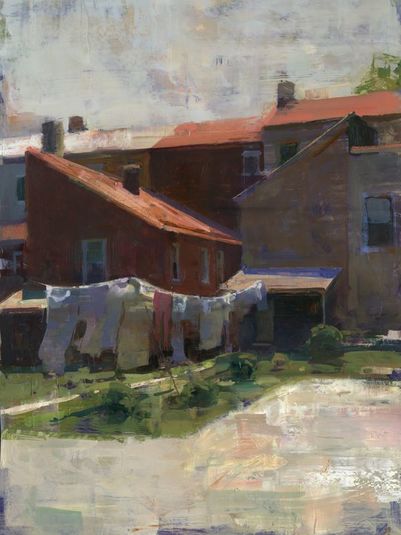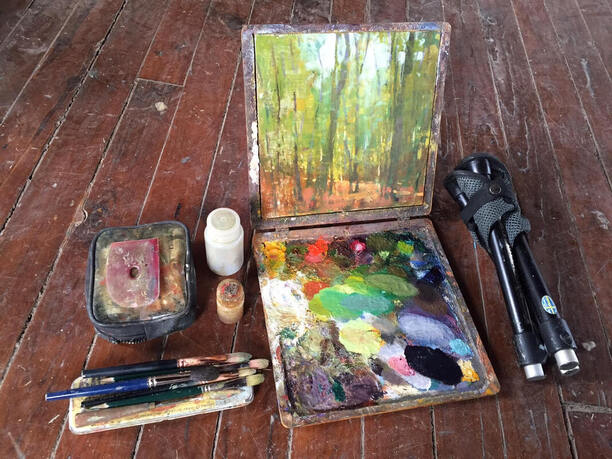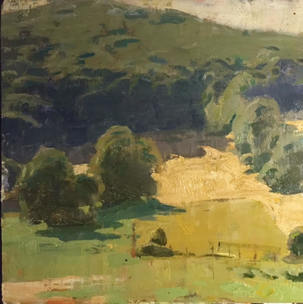
Jon Redmond 3 Day Landscape Painting Workshop
August 15 -17, 2018 (9 - 4pm)
Burnt Island Light, Boothbay Harbor, Maine (Limit 14) $450
(All inclusive accommodations, 3 prepared meals daily plus snacks, roundtrip ferry and overnight parking : $450)
Call Todd to register (603) 819-9100
Email Todd: [email protected]
** FILLED ** Wait list only **
Learn to paint forms and atmospheric space. Jon will make sense of the complexities of your oil painting materials and how best to use them for interpreting how we see. A special emphasis will be placed on the use of transparent and opaque pigments and how these relate to our perception of light. We will work outdoors (weather permitting). Jon will give demonstrations on the use of the under painting, the importance of “lost and found” form, and explanations of direct and indirect oil techniques. Intense personal instruction will be augmented with talks about the materials and the working methods of various artists (both contemporary and historical). All levels and mediums are welcome but the emphasis will be on oil.
Jon will typically demonstrate for the first three hours, then we will break for lunch. After lunch Jon will spend the remainder of the day assisting students at their easels. The workshop will be from 9 - 4pm daily.
Supply list, Itinerary and accommodations info below.
August 15 -17, 2018 (9 - 4pm)
Burnt Island Light, Boothbay Harbor, Maine (Limit 14) $450
(All inclusive accommodations, 3 prepared meals daily plus snacks, roundtrip ferry and overnight parking : $450)
Call Todd to register (603) 819-9100
Email Todd: [email protected]
** FILLED ** Wait list only **
Learn to paint forms and atmospheric space. Jon will make sense of the complexities of your oil painting materials and how best to use them for interpreting how we see. A special emphasis will be placed on the use of transparent and opaque pigments and how these relate to our perception of light. We will work outdoors (weather permitting). Jon will give demonstrations on the use of the under painting, the importance of “lost and found” form, and explanations of direct and indirect oil techniques. Intense personal instruction will be augmented with talks about the materials and the working methods of various artists (both contemporary and historical). All levels and mediums are welcome but the emphasis will be on oil.
Jon will typically demonstrate for the first three hours, then we will break for lunch. After lunch Jon will spend the remainder of the day assisting students at their easels. The workshop will be from 9 - 4pm daily.
Supply list, Itinerary and accommodations info below.

MATERIALS
These are the materials I use. I have listed a few options for each color on my palette. The color options are listed from most expensive to the cheapest. Generally, the more expensive the paint, means it will have better pigment and quality.
This is the palette I use for all of my work and my philosophy is to take only what materials I need for the day and no more. I recomend you try some of these materials out but you are welcome to use whatever you need.
If you only want to try one new thing, I would highly recommend the transparent earth yellow pigment if you have never used it.
(Pigments)
(Opaque Yellow)
(Blick Artist) cadmium yellow medium
(Rembrandt) cadmium yellow medium
(Grumbacher) cadmium/Barium yellow Mdm
(Winsor Newton) Windsor yellow
(Opaque Red)
(Blick artist) cadmium red light
(Rembrandt) cadmium red light
(Grumbacher) cadmium barium red light
(Grumbacher) grumbacher red
(Winsor Newton) Windsor red
(Transparent earth yellow)
(Old Holland) transparent Oxide yellow lake
(Blockx) Transparent mars yellow
(Gamblin) transparent earth yellow
(Rembrandt) transparent oxide yellow
(Grumbacher) transparent yellow oxide
(Transparent earth red)
(Blockx) transparent mars red
(Gamblin) transparent earth red
(Rembrandt) transparent oxide red
(Grumbacher) transparent red oxide
(Transparent earth green)
Any brand of Sap Green
I prefer (Grumbacher). Look for the darkest sap green you can find.
(Transparent Blue)
Any brand of Ultramarine Blue.
Again look for the darkest you can find.
(Gamblin) and (Old Holland) are nice.
(Cool Transparent Red)
Any brand of Alizarin Crimson
I like Winsor Newtons.
Look for a nice dark one.
(Cool Transparent Green)
Phthalo Green (any brand)
(Windsor Newton) Windsor green
Viridian green (if you can't find phthalo)
Again look for the darkest.
(White) large tube
Any brand or type of white you wish
I use (Gamblin) Flake White replacement
Zinc is cooler and more transparent, Titanium and lead are more opaque. Titanium is the brightest.
Lead or Flake is the thickest.
(Medium)
I use Original Liquin. I like its consistency and drying rate. For landscape painting I put some in this tiny 1 oz. Nalgene container.
http://www.ems.com/nalgene-wide-mouth-bottle-1-oz./1310014.html#q=Nalgene&start=21
Feel free to use any medium you prefer
(Thinner)
I recomend cheap mineral spirits from the hardware store. I put enough for a days panting in this 8 oz. Nalgene container.
http://www.ems.com/nalgene-hdpe-storage-bottle-8-oz./1310017.html#q=Nalgene&start=24
(Brushes)
I use filbert style brushes in sizes ranging from a 1/4 inch to about an inch when doing small 10"x10"ish paintings. I will be encouraging you to use a big brush so don't bring a truck load of tiny brushes. I like Blick's Masterstroke series but usually buy what is on sale. You don't really need more then 5 brushes. There is no need to carry 87 old worn out crusty brushes with you every time you go out to paint. A palette knife is handy and I also like to have tools to manipulate the paint on the painting. I usually have a soft watercolor mop brush and also use a small rubber scraper thingy.
Rags or paper towels, plastic bag, sunscreen.
(Support)
I like to paint on 1/4 inch thick birch Plywood
that I buy at the lumber yard and cut myself.
I usually ground it with 3 or 4 coats of acrylic gesso.
I also sometimes paint on Mylar (Dura-Lar) Taping it to a piece of foam core.
I will discuss that in the workshop.
I recomend you bring a few of whatever surface or surfaces (canvas,wood board, paper Mylar etc.) that you wish to paint on in a size that you can finish in a day or two. The only surface I do not recommend is the cheap canvas-boards (canvas wrapped around cardboard) They always produce truly awful paintings.
(Easel)
You will also need a portable easel or some system for working out of doors. (Or inside if the weather is bad) most folks like a French easel.
On the right is my homemade setup that I will discuss in the workshop. I sit on the small folding stool on the right and hold the painting/palette on my lap. My paints all fit into the small pouch on the left, my cut down brushes fit into the small tin they are resting on. Everything fits into a
small backpack. This and a few paper towels are all I take with me to paint.
I will be guiding you in the workshop to make decisions about your work and help you discover your own artistic path. I encourage you to explore my methods and materials but feel free to work in any manner or medium that you wish.
If you have any questions, please ask.
[email protected]
These are the materials I use. I have listed a few options for each color on my palette. The color options are listed from most expensive to the cheapest. Generally, the more expensive the paint, means it will have better pigment and quality.
This is the palette I use for all of my work and my philosophy is to take only what materials I need for the day and no more. I recomend you try some of these materials out but you are welcome to use whatever you need.
If you only want to try one new thing, I would highly recommend the transparent earth yellow pigment if you have never used it.
(Pigments)
(Opaque Yellow)
(Blick Artist) cadmium yellow medium
(Rembrandt) cadmium yellow medium
(Grumbacher) cadmium/Barium yellow Mdm
(Winsor Newton) Windsor yellow
(Opaque Red)
(Blick artist) cadmium red light
(Rembrandt) cadmium red light
(Grumbacher) cadmium barium red light
(Grumbacher) grumbacher red
(Winsor Newton) Windsor red
(Transparent earth yellow)
(Old Holland) transparent Oxide yellow lake
(Blockx) Transparent mars yellow
(Gamblin) transparent earth yellow
(Rembrandt) transparent oxide yellow
(Grumbacher) transparent yellow oxide
(Transparent earth red)
(Blockx) transparent mars red
(Gamblin) transparent earth red
(Rembrandt) transparent oxide red
(Grumbacher) transparent red oxide
(Transparent earth green)
Any brand of Sap Green
I prefer (Grumbacher). Look for the darkest sap green you can find.
(Transparent Blue)
Any brand of Ultramarine Blue.
Again look for the darkest you can find.
(Gamblin) and (Old Holland) are nice.
(Cool Transparent Red)
Any brand of Alizarin Crimson
I like Winsor Newtons.
Look for a nice dark one.
(Cool Transparent Green)
Phthalo Green (any brand)
(Windsor Newton) Windsor green
Viridian green (if you can't find phthalo)
Again look for the darkest.
(White) large tube
Any brand or type of white you wish
I use (Gamblin) Flake White replacement
Zinc is cooler and more transparent, Titanium and lead are more opaque. Titanium is the brightest.
Lead or Flake is the thickest.
(Medium)
I use Original Liquin. I like its consistency and drying rate. For landscape painting I put some in this tiny 1 oz. Nalgene container.
http://www.ems.com/nalgene-wide-mouth-bottle-1-oz./1310014.html#q=Nalgene&start=21
Feel free to use any medium you prefer
(Thinner)
I recomend cheap mineral spirits from the hardware store. I put enough for a days panting in this 8 oz. Nalgene container.
http://www.ems.com/nalgene-hdpe-storage-bottle-8-oz./1310017.html#q=Nalgene&start=24
(Brushes)
I use filbert style brushes in sizes ranging from a 1/4 inch to about an inch when doing small 10"x10"ish paintings. I will be encouraging you to use a big brush so don't bring a truck load of tiny brushes. I like Blick's Masterstroke series but usually buy what is on sale. You don't really need more then 5 brushes. There is no need to carry 87 old worn out crusty brushes with you every time you go out to paint. A palette knife is handy and I also like to have tools to manipulate the paint on the painting. I usually have a soft watercolor mop brush and also use a small rubber scraper thingy.
Rags or paper towels, plastic bag, sunscreen.
(Support)
I like to paint on 1/4 inch thick birch Plywood
that I buy at the lumber yard and cut myself.
I usually ground it with 3 or 4 coats of acrylic gesso.
I also sometimes paint on Mylar (Dura-Lar) Taping it to a piece of foam core.
I will discuss that in the workshop.
I recomend you bring a few of whatever surface or surfaces (canvas,wood board, paper Mylar etc.) that you wish to paint on in a size that you can finish in a day or two. The only surface I do not recommend is the cheap canvas-boards (canvas wrapped around cardboard) They always produce truly awful paintings.
(Easel)
You will also need a portable easel or some system for working out of doors. (Or inside if the weather is bad) most folks like a French easel.
On the right is my homemade setup that I will discuss in the workshop. I sit on the small folding stool on the right and hold the painting/palette on my lap. My paints all fit into the small pouch on the left, my cut down brushes fit into the small tin they are resting on. Everything fits into a
small backpack. This and a few paper towels are all I take with me to paint.
I will be guiding you in the workshop to make decisions about your work and help you discover your own artistic path. I encourage you to explore my methods and materials but feel free to work in any manner or medium that you wish.
If you have any questions, please ask.
[email protected]
ITINERARY
Day 1: Wednesday, August 15, 2018: Arrive and park at the Maine State Aquarium in Boothbay harbor to board ferry to the island.
194 McKown Point Rd, West Boothbay Harbor, Maine. Please bring all your overnight gear, art supplies and everything you will need for the duration of the workshop to the dock to board the water taxi. The water taxi will take students at 9am to a short ferry ride, (maybe ten to fifteen minutes) to Burnt Island. You will be lead to the overnight quarters, drop your luggage in your bunk and report downstairs to the dining area / school house. We will assemble there with our art supplies. We will be briefed shortly by Elaine Jones, the Island curator and host. The workshop will then be in the capable hands of Jon Redmond. Daily workshop is officially from 9am - 4pm. We will eat meals, study, learn and paint together. This will be an amazing experience.
Day 2: Class starts after breakfast. Breakfast is served from 7:30 - 9:00, downstairs from your sleeping quarters. Students assemble for Jon's lecture after breakfast, followed by outdoor painting until 4pm. Elaine will ring the lunch and dinner bell during the day. Snacks and drinks are always available in the kitchen.
Day 3: Class starts after breakfast. Breakfast is served from 7:30 - 9:00, downstairs from your sleeping quarters. Students assemble for Jon's lecture after breakfast, followed by outdoor painting until 4pm. Ferry departs after dinner. (weather conditions can affect the captains departure time).
ACCOMODATIONS:
This unique experience to stay and paint on a private, 5 acre island with a lighthouse in coastal Maine is a once in a lifetime opportunity. We will stay in a dorm-like bunkhouse with private showers, shared bathrooms and a full kitchen. Three meals daily, snacks and beverages are included in a separate, all-inclusive accommodations and meal package. All you need to bring is appropriate clothing for August weather, bug spray, sun screen, and art supplies, a pillow, bed sheet, blanket or sleeping bag. Everything else is covered. The island is quaint with it's own working lighthouse, keepers house, classroom building, mess hall, boat house, dock, giant Pines, rocky ledges, stoney beach, charming pathway trails, meadows and spectacular light.
Day 1: Wednesday, August 15, 2018: Arrive and park at the Maine State Aquarium in Boothbay harbor to board ferry to the island.
194 McKown Point Rd, West Boothbay Harbor, Maine. Please bring all your overnight gear, art supplies and everything you will need for the duration of the workshop to the dock to board the water taxi. The water taxi will take students at 9am to a short ferry ride, (maybe ten to fifteen minutes) to Burnt Island. You will be lead to the overnight quarters, drop your luggage in your bunk and report downstairs to the dining area / school house. We will assemble there with our art supplies. We will be briefed shortly by Elaine Jones, the Island curator and host. The workshop will then be in the capable hands of Jon Redmond. Daily workshop is officially from 9am - 4pm. We will eat meals, study, learn and paint together. This will be an amazing experience.
Day 2: Class starts after breakfast. Breakfast is served from 7:30 - 9:00, downstairs from your sleeping quarters. Students assemble for Jon's lecture after breakfast, followed by outdoor painting until 4pm. Elaine will ring the lunch and dinner bell during the day. Snacks and drinks are always available in the kitchen.
Day 3: Class starts after breakfast. Breakfast is served from 7:30 - 9:00, downstairs from your sleeping quarters. Students assemble for Jon's lecture after breakfast, followed by outdoor painting until 4pm. Ferry departs after dinner. (weather conditions can affect the captains departure time).
ACCOMODATIONS:
This unique experience to stay and paint on a private, 5 acre island with a lighthouse in coastal Maine is a once in a lifetime opportunity. We will stay in a dorm-like bunkhouse with private showers, shared bathrooms and a full kitchen. Three meals daily, snacks and beverages are included in a separate, all-inclusive accommodations and meal package. All you need to bring is appropriate clothing for August weather, bug spray, sun screen, and art supplies, a pillow, bed sheet, blanket or sleeping bag. Everything else is covered. The island is quaint with it's own working lighthouse, keepers house, classroom building, mess hall, boat house, dock, giant Pines, rocky ledges, stoney beach, charming pathway trails, meadows and spectacular light.

Jon Redmond www.JonRedmond.com
Jon Redmond is a contemporary American painter known for his light filled landscapes and paintings of architecture. He is a graduate of the West Chester University, Pennsylvania Academy of the Fine Arts and earned his Masters of Fine Art from the University of Delaware. Aside from being honored with numerous awards, his paintings are in many selected collections including the Delaware Art Museum, Brandywine Valley Association, Arco Chemical Corporation and Vermont Studio Center. Jon has been teaching throughout the United States for many years and he has been featured in numerous art publications, newspapers and magazines.
Jon Redmond is a contemporary American painter known for his light filled landscapes and paintings of architecture. He is a graduate of the West Chester University, Pennsylvania Academy of the Fine Arts and earned his Masters of Fine Art from the University of Delaware. Aside from being honored with numerous awards, his paintings are in many selected collections including the Delaware Art Museum, Brandywine Valley Association, Arco Chemical Corporation and Vermont Studio Center. Jon has been teaching throughout the United States for many years and he has been featured in numerous art publications, newspapers and magazines.